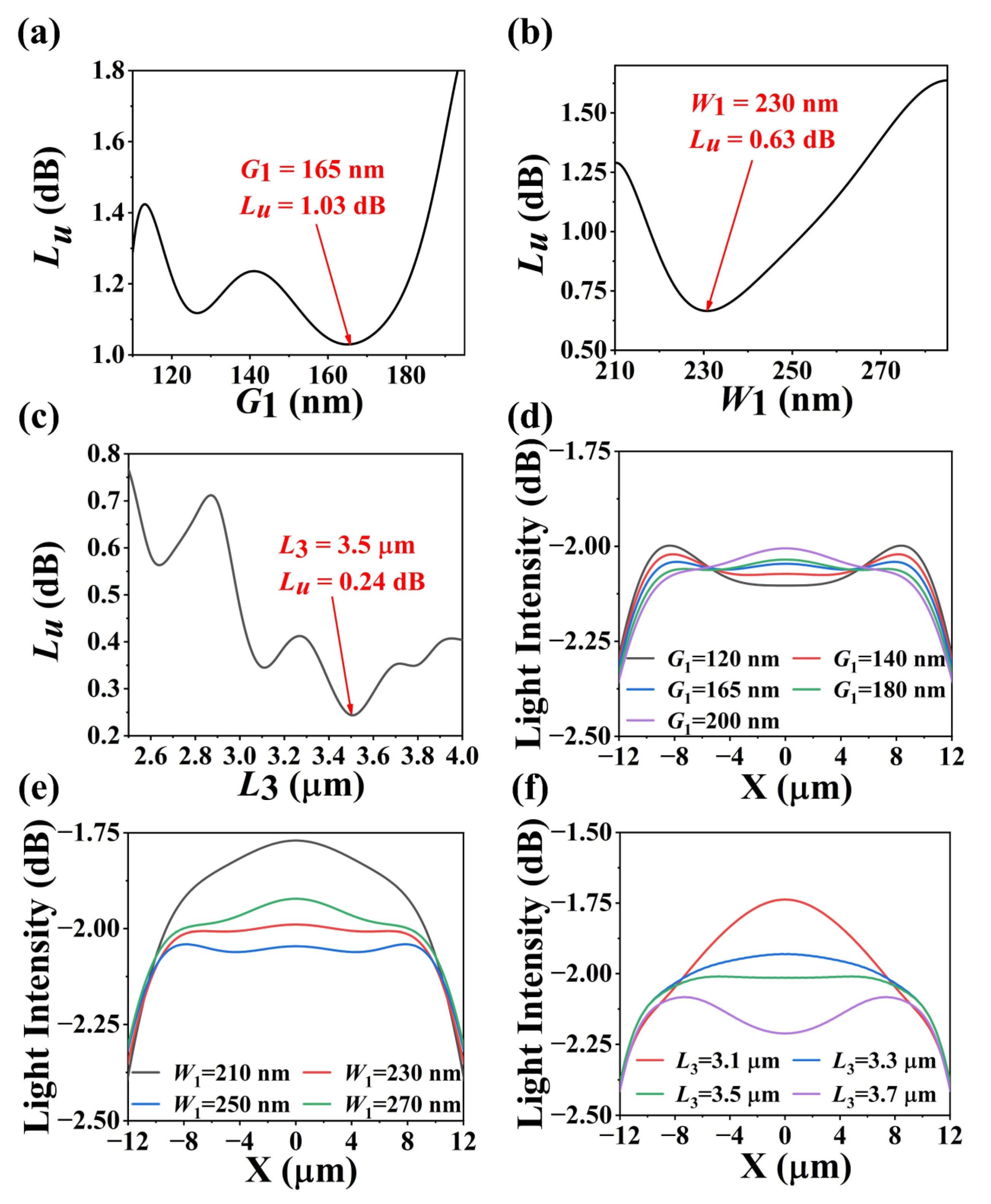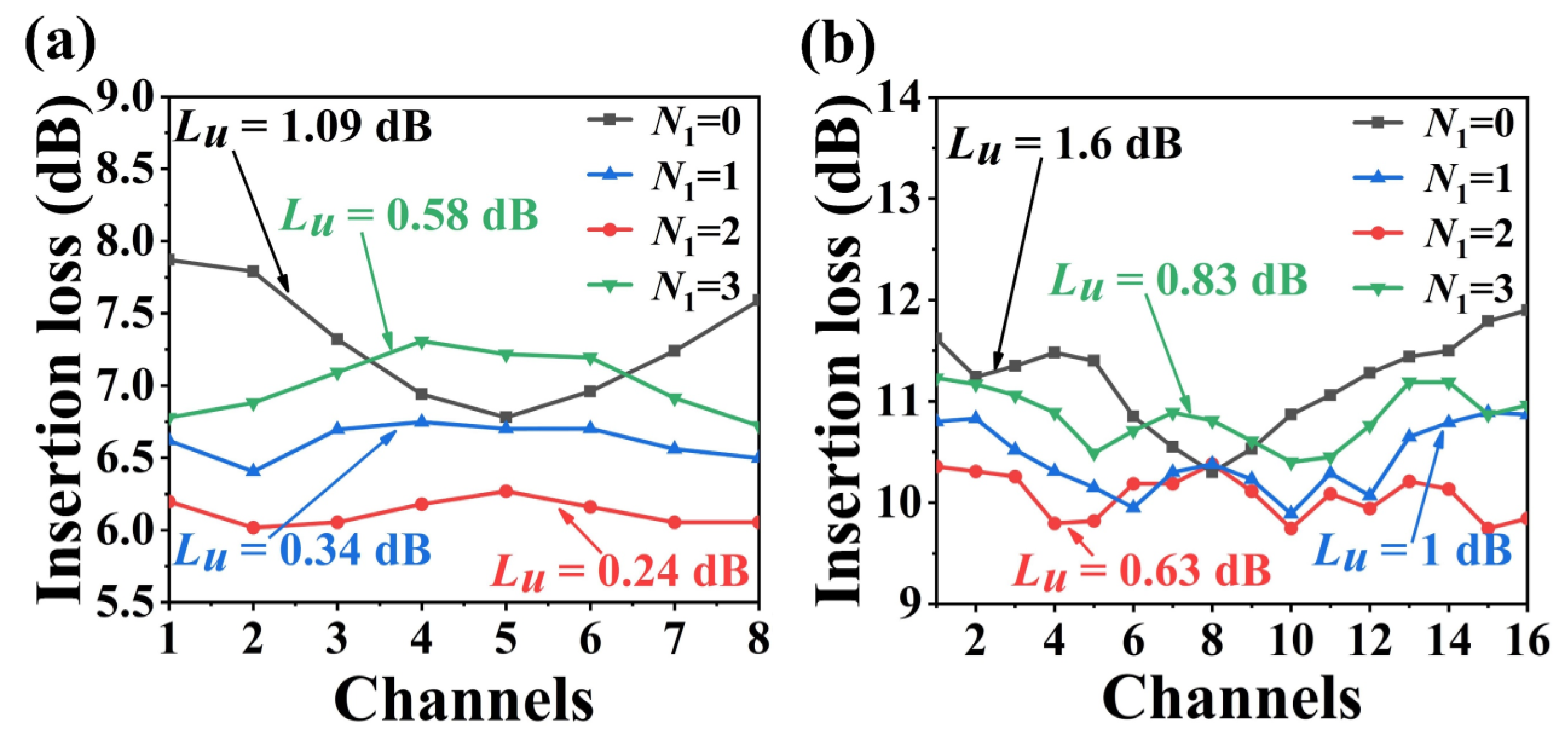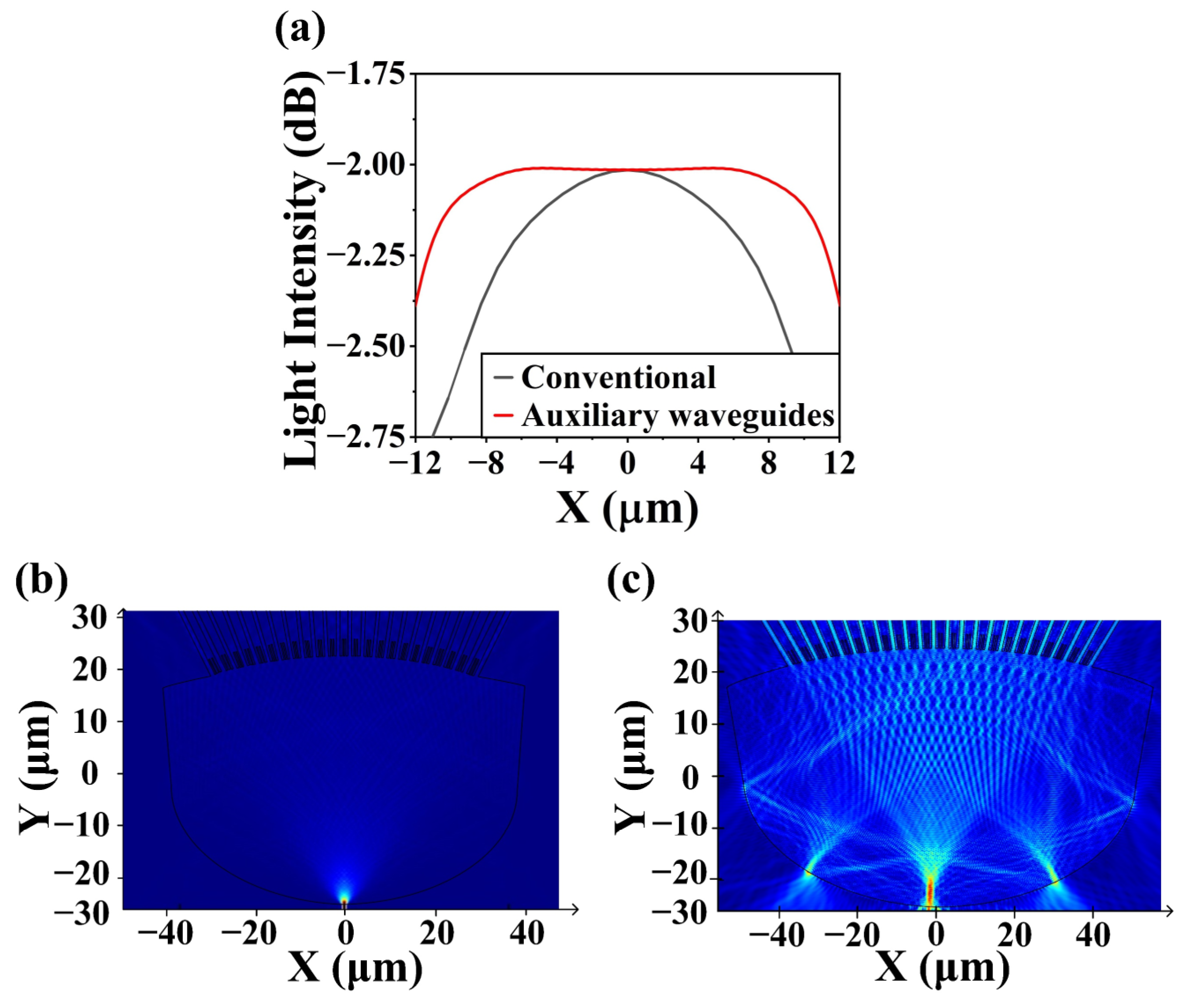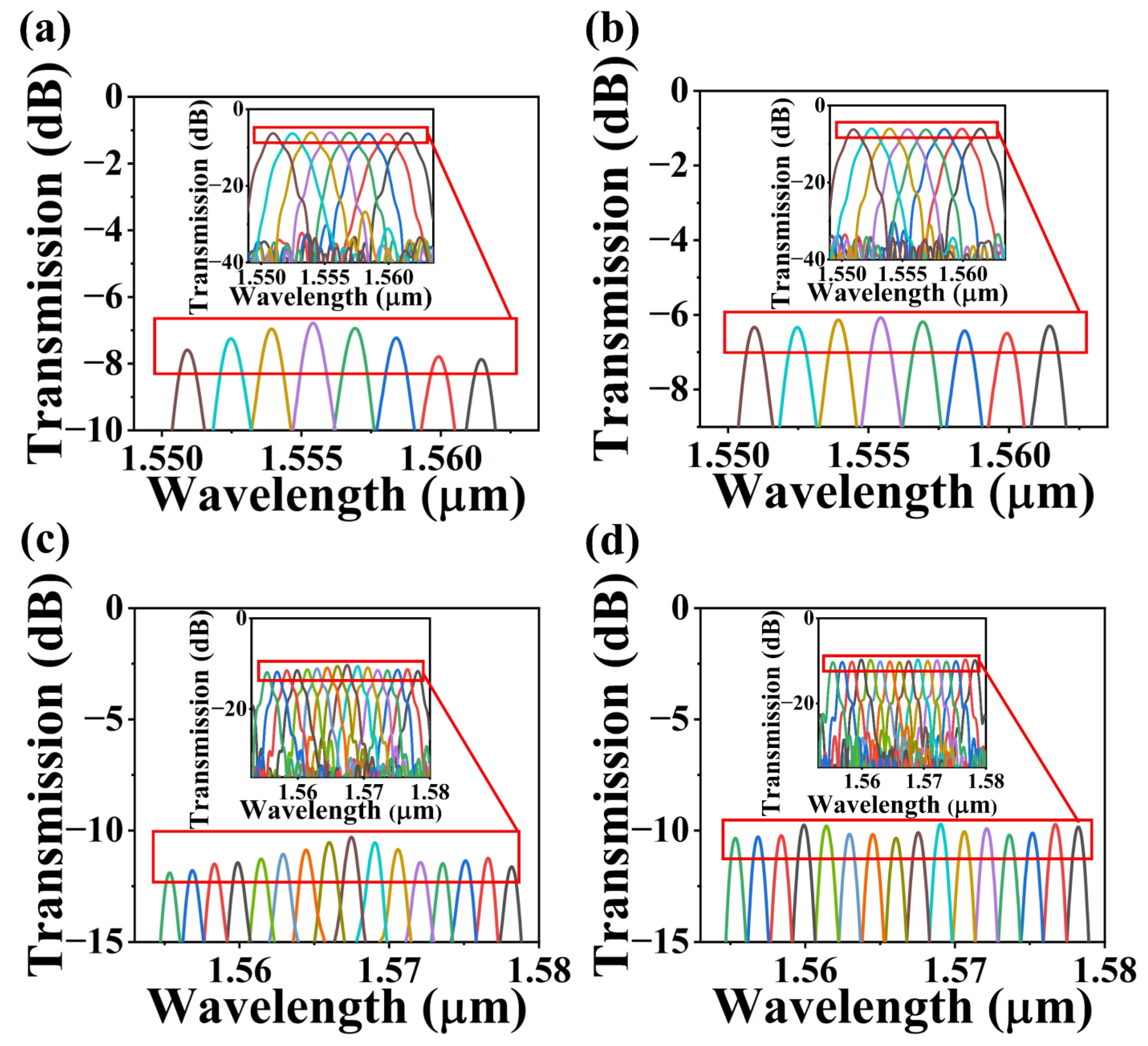Silicon Nanowire-Assisted High Uniform Arrayed Waveguide Grating
Abstract
:1. Introduction
2. Device Structure and Design
3. Device Performance and Discussion
4. Conclusions
Author Contributions
Funding
Data Availability Statement
Conflicts of Interest
References
- Liu, M.; Yin, X.B.; Ulin-Avila, E.; Geng, B.S.; Zentgraf, T.; Ju, L.; Wang, F.; Zhang, X. A graphene-based broadband optical modulator. Nature 2011, 474, 64–67. [Google Scholar] [CrossRef] [PubMed]
- Li, M.X.; Huang, Z.N.; Liu, Z.Y.; Jiang, C.; Mou, C.B.; Liu, Y.Q. Tunable Broadband Mode Converter Based on Long-Period Fiber Gratings at 2-μm Waveband. J. Light. Technol. 2021, 39, 5134–5141. [Google Scholar] [CrossRef]
- Blau, M.; Marom, D.M. Spatial aperture-sampled mode multiplexer extended to higher mode count fibers. J. Light. Technol. 2015, 33, 4805–4814. [Google Scholar] [CrossRef]
- Chen, Y.; Tang, W. Reconfigurable asymmetric optical burst switching for concurrent dwdm multimode switching: Architecture and research directions [topics in optical communications]. IEEE Commun. Mag. 2010, 48, 57–65. [Google Scholar] [CrossRef]
- Hao, Y.L.; Wu, Y.M.; Yang, J.Y.; Jiang, X.Q.; Wang, M.H. Novel dispersive and focusing device configuration based on curved waveguide grating (CWG). Opt. Express 2006, 14, 8630–8637. [Google Scholar] [CrossRef]
- Ma, X.; Yu, J.; Hua, X.; Wei, C.; Huang, Y.; Yang, L.; Li, D.; Hao, Q.; Liu, P.; Jiang, X. LioeSim: A network simulator for hybrid opto-electronic networks-on-chip analysis. J. Light. Technol. 2014, 32, 4301–4310. [Google Scholar] [CrossRef]
- Ye, T.; Fu, Y.; Qiao, L.; Chu, T. Low-crosstalk Si arrayed waveguide grating with parabolic tapers. Opt. Express 2014, 22, 31899–31906. [Google Scholar] [CrossRef]
- Zou, J.; Le, Z.C.; Hu, J.H.; He, J.J. Performance improvement for silicon-based arrayed waveguide grating router. Opt. Express 2017, 25, 9963–9973. [Google Scholar] [CrossRef]
- Okamoto, K.; Ishida, K. Fabrication of silicon reflection-type arrayed-waveguide gratings with distributed Bragg reflectors. Opt. Lett. 2013, 38, 3530–3533. [Google Scholar] [CrossRef]
- Doerr, C.R.; Zhang, L.; Winzer, P.J. Monolithic InP multiwavelength coherent receiver using a chirped arrayed waveguide grating. J. Light. Technol. 2010, 29, 536–541. [Google Scholar] [CrossRef]
- Takada, K.; Yamada, H.; Inoue, Y. Optical low coherence method for characterizing silica-based arrayed-waveguide grating multiplexers. J. Light. Technol. 1996, 14, 1677–1689. [Google Scholar] [CrossRef]
- Lu, S.; Yang, C.X.; Yan, Y.B.; Jin, G.F.; Zhou, Z.Y.; Wong, W.H.; Pun, E. Design and fabrication of a polymeric flat focal field arrayed waveguide grating. Opt. Express 2005, 13, 9982–9994. [Google Scholar] [CrossRef] [PubMed]
- Wang, J.; Sheng, Z.; Li, L.; Pang, A.; Wu, A.; Li, W.; Wang, X.; Zou, S.; Qi, M.; Gan, F. Low-loss and low-crosstalk 8 × 8 silicon nanowire AWG routers fabricated with CMOS technology. Opt. Express 2014, 22, 9395–9403. [Google Scholar] [CrossRef] [PubMed] [Green Version]
- Park, J.; Joo, J.; Kwack, M.J.; Kim, G.; Han, S.P.; Kim, S. Three-dimensional wavelength-division multiplexing interconnects based on a low-loss SixNy arrayed waveguide grating. Opt. Express 2021, 29, 35261–35270. [Google Scholar] [CrossRef]
- Soref, R. The past, present, and future of silicon photonics. IEEE J. Sel. Top. Quantum Electron. 2006, 12, 1678–1687. [Google Scholar] [CrossRef]
- Bogaerts, W.; Selvaraja, S.K.; Dumon, P.; Brouckaert, J.; De Vos, K.; Van Thourhout, D.; Baets, R. Silicon-on-insulator spectral filters fabricated with CMOS technology. IEEE J. Sel. Top. Quantum Electron. 2010, 16, 33–44. [Google Scholar] [CrossRef]
- Won, R. Integrating silicon photonics. Nat. Photonics 2010, 4, 498–499. [Google Scholar] [CrossRef]
- Atabaki, A.H.; Eftekhar, A.A.; Askari, M.; Adibi, A. Accurate post-fabrication trimming of ultra-compact resonators on silicon. Opt. Express 2013, 21, 14139–14145. [Google Scholar] [CrossRef]
- Liu, H.; Feng, J.; Ge, J.; Zhuang, S.; Yuan, S.; Chen, Y.; Li, X.; Tan, Q.; Yu, Q.; Zeng, H. Tilted Nano-Grating Based Ultra-Compact Broadband Polarizing Beam Splitter for Silicon Photonics. Nanomaterials 2021, 11, 2645. [Google Scholar] [CrossRef]
- Nishi, H.; Tsuchizawa, T.; Kou, R.; Shinojima, H.; Yamada, T.; Kimura, H.; Ishikawa, Y.; Wada, K.; Yamada, K. Monolithic integration of a silica AWG and Ge photodiodes on Si photonic platform for one-chip WDM receiver. Opt. Express 2012, 20, 9312–9321. [Google Scholar] [CrossRef]
- Song, G.Y.; Wang, S.X.; Zou, J.; Lang, T.T.; He, J.J. Silicon-based cyclic arrayed waveguide grating routers with improved loss uniformity. Opt. Commun. 2018, 427, 628–634. [Google Scholar] [CrossRef]
- Xia, X.; Lang, T.T.; Zhang, L.B.; Yu, Z.H. Reduction of non-uniformity for a 16 × 16 arrayed waveguide grating router based on silica waveguides. Appl. Opt. 2019, 58, 1139–1145. [Google Scholar] [CrossRef] [PubMed]
- Piels, M.; Bauters, J.F.; Davenport, M.L.; Heck, M.J.R.; Bowers, J.E. Low-Loss Silicon Nitride AWG Demultiplexer Heterogeneously Integrated With Hybrid III–V/Silicon Photodetectors. J. Light. Technol. 2014, 32, 817–823. [Google Scholar] [CrossRef]
- Yu, R.; Cheung, S.; Li, Y.; Okamoto, K.; Proietti, R.; Yin, Y.; Yoo, S.J.B. A scalable silicon photonic chip-scale optical switch for high performance computing systems. Opt. Express 2013, 21, 32655–32667. [Google Scholar] [CrossRef] [PubMed]
- Alexoudi, T.; Terzenidis, N.; Pitris, S.; Moralis-Pegios, M.; Maniotis, P.; Vagionas, C.; Mitsolidou, C.; Mourgias-Alexandris, G.; Kanellos, G.T.; Miliou, A. Optics in computing: From photonic network-on-chip to chip-to-chip interconnects and disintegrated architectures. J. Light. Technol. 2019, 37, 363–379. [Google Scholar] [CrossRef] [Green Version]
- Lee, J.H.; Choi, H.Y.; Shin, S.K.; Chung, Y.C. A Review of the Polarization-Nulling Technique for Monitoring Optical-Signal-to-Noise Ratio in Dynamic WDM Networks. J. Light. Technol. 2006, 24, 4162–4171. [Google Scholar] [CrossRef]
- Sakamaki, Y.; Kamei, S.; Hashimoto, T.; Kitoh, T.; Takahashi, H. Loss uniformity improvement of arrayed-waveguide grating with mode-field converters designed by wavefront matching method. J. Light. Technol. 2009, 27, 5710–5715. [Google Scholar] [CrossRef]
- Hashimoto, T.; Saida, T.; Ogawa, I.; Kohtoku, M.; Shibata, T.; Takahashi, H. Optical circuit design based on a wavefront-matching method. Opt. Lett. 2005, 30, 2620–2622. [Google Scholar] [CrossRef]
- Sakamaki, Y.; Saida, T.; Hashimoto, T.; Takahashi, H. New optical waveguide design based on wavefront matching method. J. Light. Technol. 2007, 25, 3511–3518. [Google Scholar] [CrossRef]
- Takiguchi, K.; Okamoto, K.; Sugita, A. Arrayed-waveguide grating with uniform loss properties over the entire range of wavelength channels. Opt. Lett. 2006, 31, 459–461. [Google Scholar] [CrossRef]
- Chen, Y.; Wang, S.X.; Lang, T.T.; He, J.J. Uniform-loss cyclic arrayed waveguide grating router using a mode-field converter based on a slab coupler and auxiliary waveguides. Opt. Lett. 2019, 44, 211–214. [Google Scholar] [CrossRef] [PubMed]
- Kamei, S.; Ishii, M.; Kaneko, A.; Shibata, T.; Itoh, M. N × N Cyclic-Frequency Router With Improved Performance Based on Arrayed-Waveguide Grating. J. Lightwave Technol. 2009, 27, 4097–4104. [Google Scholar] [CrossRef]
- Pathak, S.; Vanslembrouck, M.; Dumon, P.; Van Thourhout, D.; Bogaerts, W. Optimized silicon AWG with flattened spectral response using an MMI aperture. J. Light. Technol. 2013, 31, 87–93. [Google Scholar] [CrossRef] [Green Version]
- Sheng, Z.; Dai, D.; He, S. Improve channel uniformity of an Si-nanowire AWG demultiplexer by using dual-tapered auxiliary waveguides. J. Light. Technol. 2007, 25, 3001–3007. [Google Scholar] [CrossRef]
- Smit, M.K.; Van Dam, C. PHASAR-based WDM-devices: Principles, design and applications. IEEE J. Sel. Top. Quantum Electron. 1996, 2, 236–250. [Google Scholar] [CrossRef] [Green Version]
- Zou, J.; Ma, X.; Xia, X.; Hu, J.; Wang, C.; Zhang, M.; Lang, T.; He, J.-J. High resolution and ultra-compact on-chip spectrometer using bidirectional edge-input arrayed waveguide grating. J. Light. Technol. 2020, 38, 4447–4453. [Google Scholar] [CrossRef]
- Chen, Y.S.; Feng, J.J.; Chen, J.; Liu, H.P.; Yuan, S.; Guo, S.; Yu, Q.H.; Zeng, H.P. Optical Bistability in a Tunable Gourd-Shaped Silicon Ring Resonator. Nanomaterials 2022, 12, 2447. [Google Scholar] [CrossRef]
- Xiao, S.; Khan, M.H.; Shen, H.; Qi, M. Multiple-channel silicon micro-resonator based filters for WDM applications. Opt. Express 2007, 15, 7489–7498. [Google Scholar] [CrossRef]
- Pan, P.; An, J.; Zhang, J.; Wang, Y.; Wang, H.; Wang, L.; Yin, X.; Wu, Y.; Li, J.; Han, Q. Flat-top AWG based on InP deep ridge waveguide. Opt. Commun. 2015, 355, 376–381. [Google Scholar] [CrossRef]







| Design Parameter | ||
|---|---|---|
| Number of channels | 8 | 16 |
| Center wavelength (nm) | 1556 | 1556 |
| Channel spacing (nm) | 1.6 | 1.6 |
| Free spectral range (nm) | 23.39 | 25.99 |
| Single mode waveguide width (nm) | 500 | 500 |
| Diffraction order | 40 | 36 |
| Length increment (μm) | 25.34 | 22.80 |
| Pitch of adjacent arrayed waveguides (μm) | 1.4 | 1.4 |
| Length of star coupler (μm) | 30 | 50 |
| Number of arrayed waveguides | 26 | 24 |
| Number of nanowires | 2 | 2 |
| Spacing between nanowires and arrayed waveguides (nm) | 165 | 165 |
| Width of nanowires (nm) | 230 | 230 |
| Length of nanowires (μm) | 3.5 | 3.5 |
| Structures | Non-Uniformity | Channels | Additional Insertion Loss | Cross-Talk | Year |
|---|---|---|---|---|---|
| Conventional [8] | 3 | 15 | 3.5 dB | −19 dB | 2017 |
| Optical Combiner Structures [30] | 1.8 | 32 | 4.65 dB | −38 dB | 2009 |
| AWG with MMI [33] | 0.8 dB | 12 | 2.07 dB | −19.5 dB | 2013 |
| Parabolic MMI [39] | 1.4 dB | 10 | 2 dB | −25.4 dB | 2015 |
| Dual-tapered assisted waveguides [21] | 1.9 dB | 15 | 1.1 dB | −15 dB | 2018 |
| Cyclic Arrayed waveguides [22] | 1.02 dB | 16 | 2.45 dB | 22 dB | 2019 |
| Mode field converters [31] | 0.5 dB | 16 | 1.524 dB | −32 dB | 2019 |
| This work | 0.24/0.63 dB | 8/16 | 0 dB | −27/−20.7 dB | 2022 |
Disclaimer/Publisher’s Note: The statements, opinions and data contained in all publications are solely those of the individual author(s) and contributor(s) and not of MDPI and/or the editor(s). MDPI and/or the editor(s) disclaim responsibility for any injury to people or property resulting from any ideas, methods, instructions or products referred to in the content. |
© 2022 by the authors. Licensee MDPI, Basel, Switzerland. This article is an open access article distributed under the terms and conditions of the Creative Commons Attribution (CC BY) license (https://creativecommons.org/licenses/by/4.0/).
Share and Cite
Yuan, S.; Feng, J.; Yu, Z.; Chen, J.; Liu, H.; Chen, Y.; Guo, S.; Huang, F.; Akimoto, R.; Zeng, H. Silicon Nanowire-Assisted High Uniform Arrayed Waveguide Grating. Nanomaterials 2023, 13, 182. https://doi.org/10.3390/nano13010182
Yuan S, Feng J, Yu Z, Chen J, Liu H, Chen Y, Guo S, Huang F, Akimoto R, Zeng H. Silicon Nanowire-Assisted High Uniform Arrayed Waveguide Grating. Nanomaterials. 2023; 13(1):182. https://doi.org/10.3390/nano13010182
Chicago/Turabian StyleYuan, Shuo, Jijun Feng, Zhiheng Yu, Jian Chen, Haipeng Liu, Yishu Chen, Song Guo, Fengli Huang, Ryoichi Akimoto, and Heping Zeng. 2023. "Silicon Nanowire-Assisted High Uniform Arrayed Waveguide Grating" Nanomaterials 13, no. 1: 182. https://doi.org/10.3390/nano13010182
APA StyleYuan, S., Feng, J., Yu, Z., Chen, J., Liu, H., Chen, Y., Guo, S., Huang, F., Akimoto, R., & Zeng, H. (2023). Silicon Nanowire-Assisted High Uniform Arrayed Waveguide Grating. Nanomaterials, 13(1), 182. https://doi.org/10.3390/nano13010182










